Mikroelektronika d.o.o.
Color 17 Click Board
Color 17 Click Board
Couldn't load pickup availability
Key Features
- Four channels for close mimic of the human eye spectra, high precision and resolution, built-in automatic full-scale light range selection, configurable conversion times, reject the NIR region, interrupt and hardware synchronized triggers, low power consumption, and more
- Based on the OPT4048 - high-speed precision tristimulus XYZ color sensor from Texas Instruments
- Can be used for the development of applications for camera image correction, auto white balancing, lighting control systems, building automation and control, or general display brightness and color adjustments
- mikroBUS: I2C Interface
Unleash the Power of Accurate Colour-Sensing with Color 17 Click Board™
Step into the future of colour sensing with the Color 17 Click Board™. This compact, high-performance add-on board is your ultimate solution to accurate colour-sensing. At its heart lies the OPT4048, a state-of-the-art, high-speed precision tristimulus XYZ colour sensor developed by industry leader Texas Instruments. Boasting four sensing channels, the sensor uses precision optical filters that brilliantly mimic human eye vision.
Unmatched Speed and Precision
With the Color 17 Click Board™, experience the superior blend of speed and precision. The OPT4048 sensor comes with 12 configurable conversion times, ranging from as short as 600μs to as long as 800ms. This allows for synchronous or asynchronous reading of measurements. Furthermore, the sensor is not overly sensitive to micro-shadows or small particles on the optical surface, ensuring you get reliable, precise data every time.
Endless Applications
Whether you're developing applications for camera image correction, auto-white balancing, lighting control systems, building automation and control, or even general display brightness and colour adjustments, the Color 17 Click Board™ is the perfect fit for your needs.
Backed by mikroSDK Compliant Library
To simplify your software development, the Color 17 Click Board™ is supported by a mikroSDK-compliant library packed with functions tailored to your needs.
Ready-to-Use and Fully Tested
Our commitment to quality and reliability ensures that the Color 17 Click Board™ comes to you as a fully tested product, ready to be integrated into a system equipped with a mikroBUS™ socket. Experience hassle-free, advanced colour-sensing like never before.
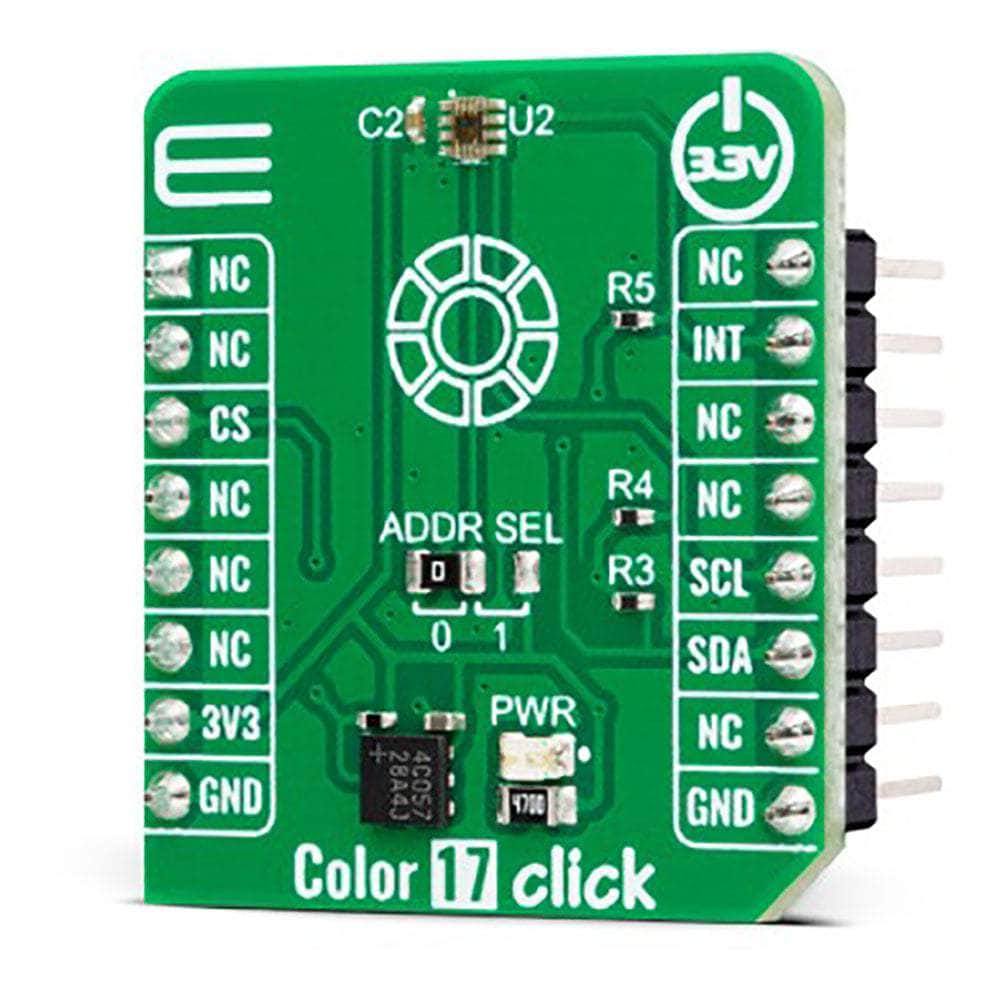
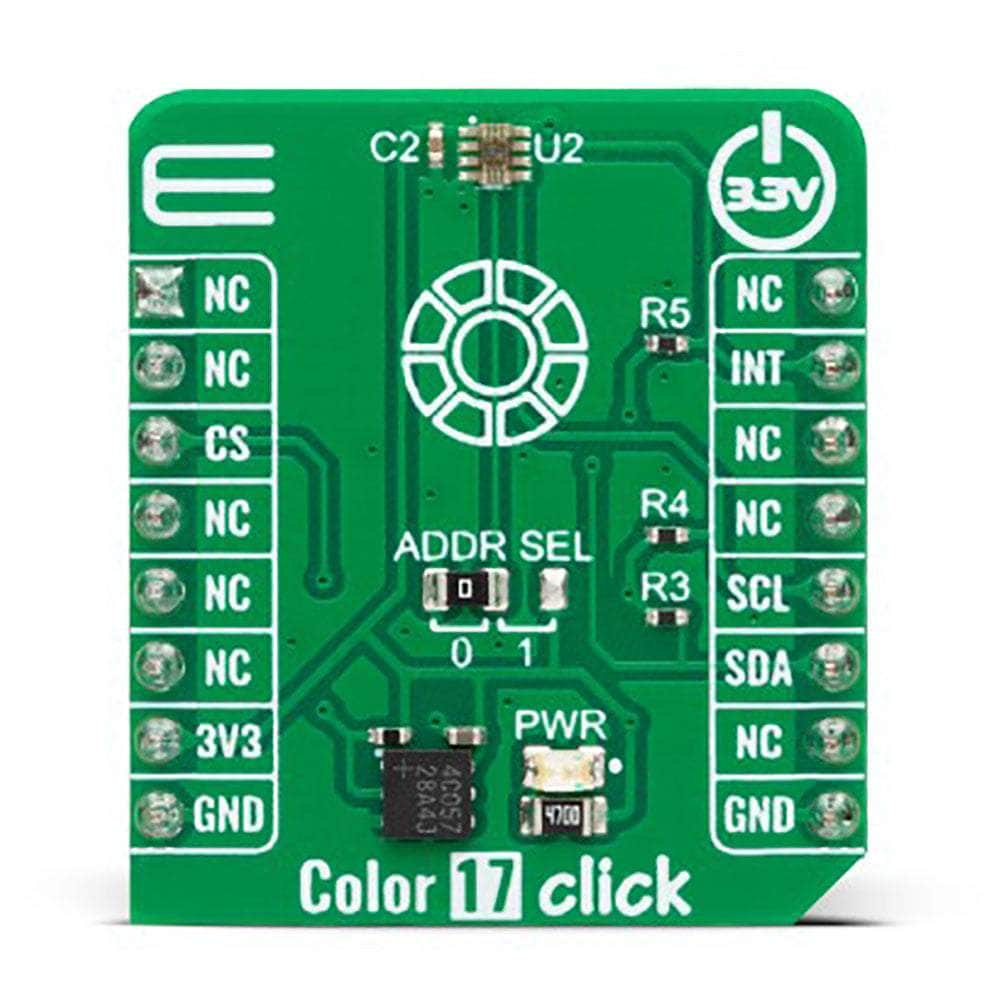
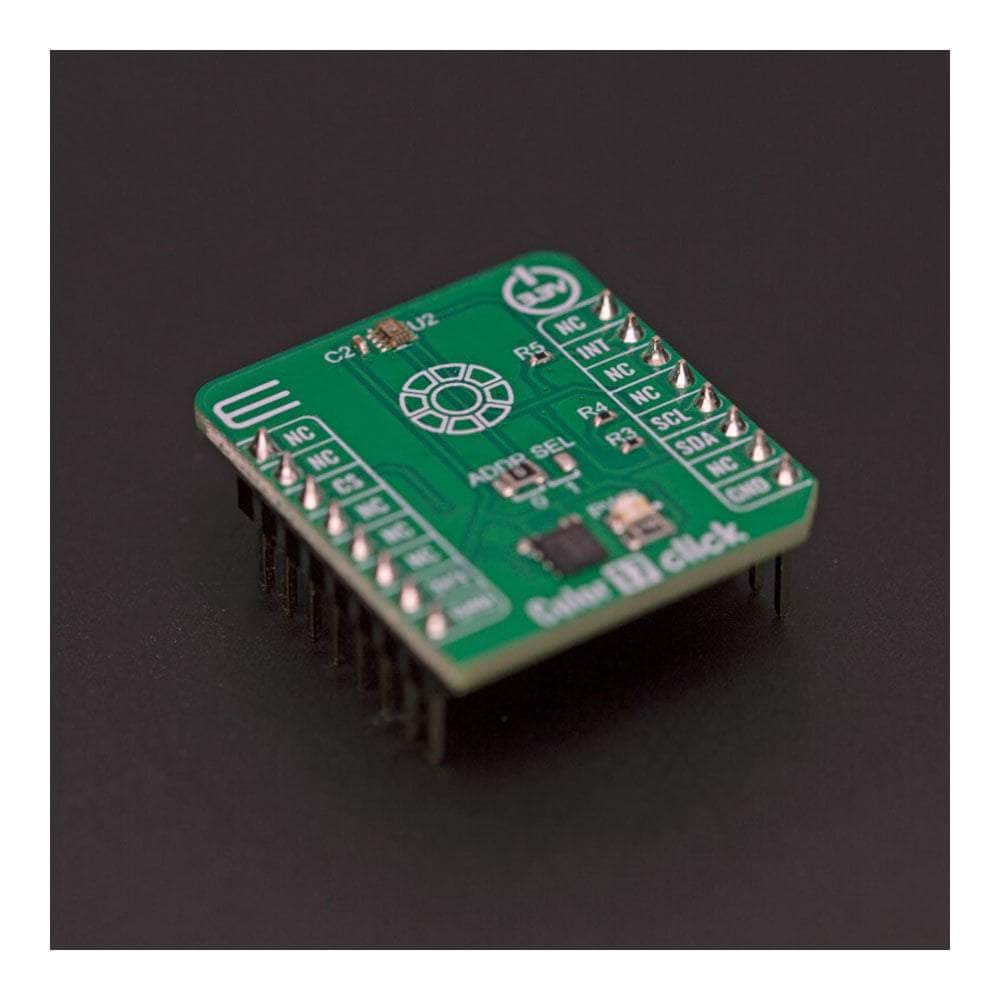
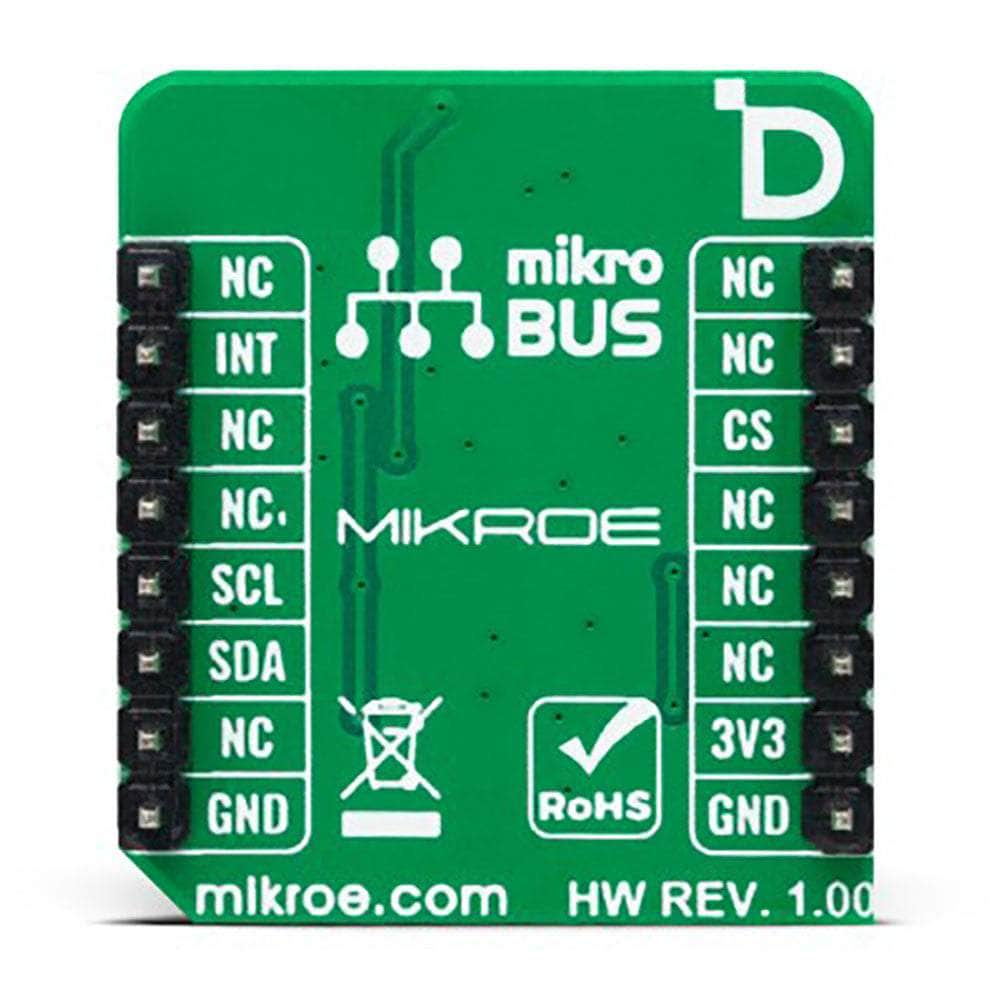
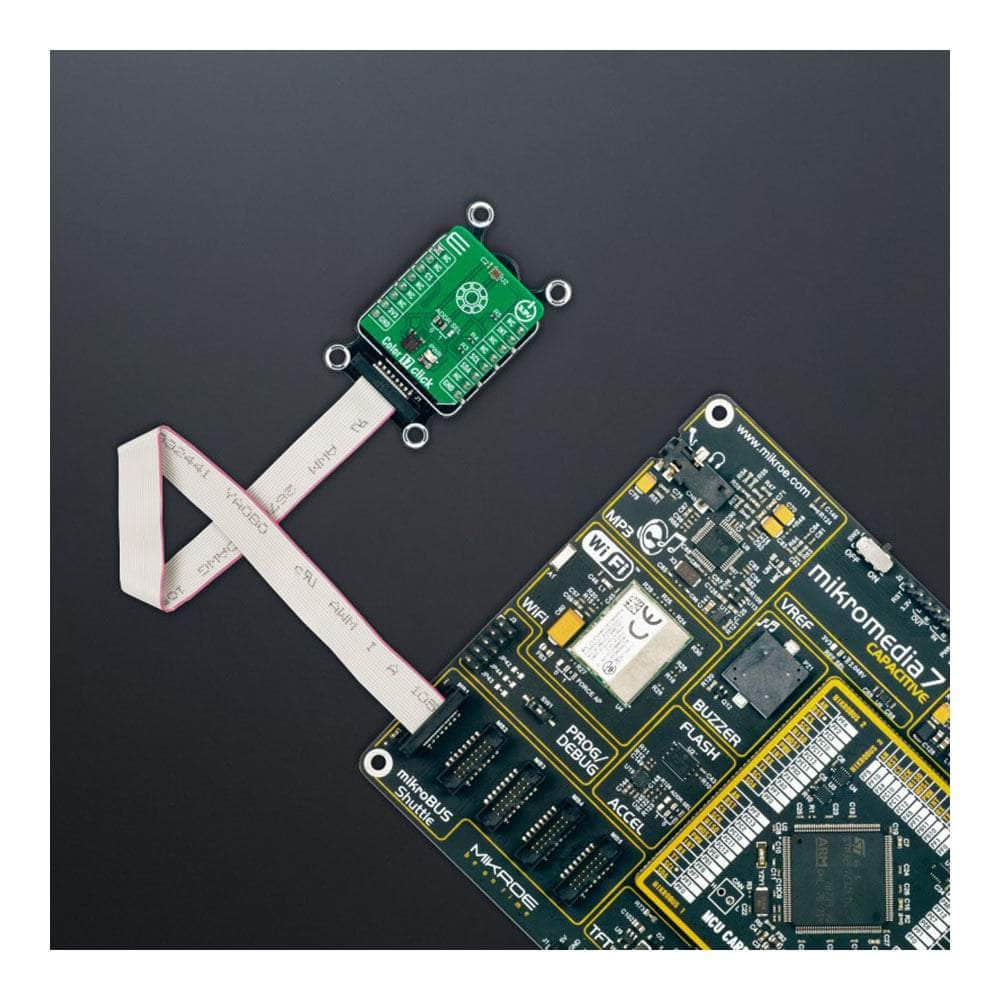


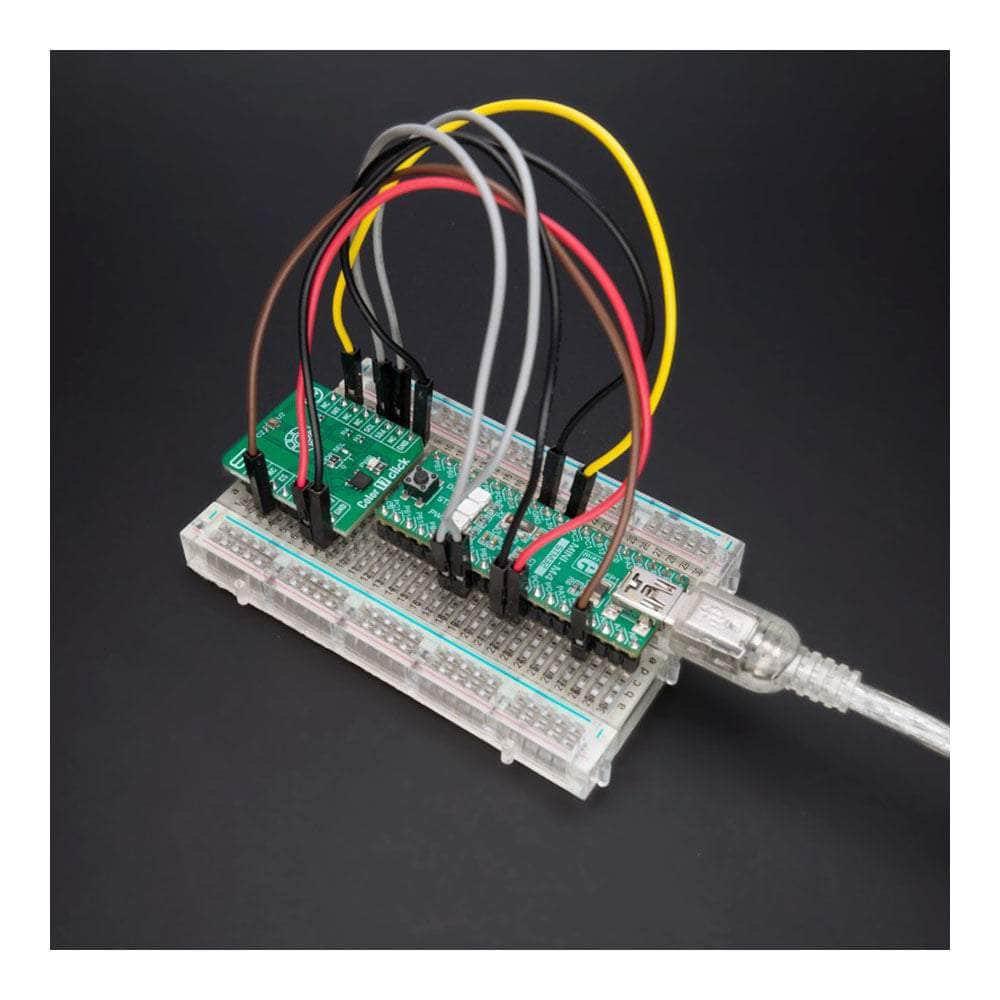
How Does The Color 17 Click Board™ Work?
The Color 17 Click Board™ is based on the OPT4048, a high-speed precision tristimulus XYZ colour sensor from Texas Instruments, designed to mimic the human eye's normal vision. The human eye has spectral sensitivity in short, middle, and long wavelengths but is correlated with a range of brightness. The CIE XYZ colour space represents all colour sensations visible to an average human eye, where the X is a mix of the three CIE RGB curves, the Y is the illuminance, and the Z is a quasi-equal to blue, according to the CIE 1931 model. The CIE XYZ is fixed colour space, and one must note that there is a difference between the objects that emits light (and colour) and objects that reflect light (and colour). To put it more clearly, the monitor you look at and the wall behind it.
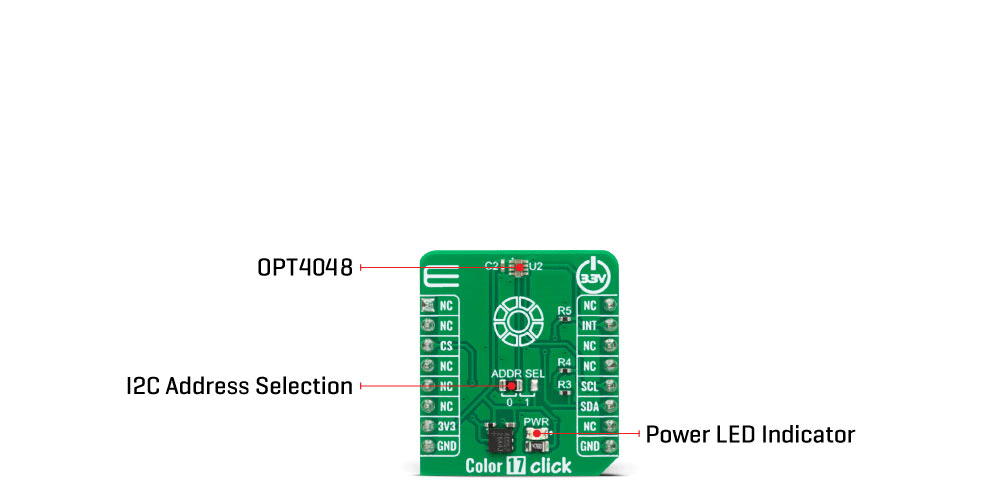
The OPT4048 has three channels closely matching the CIE tristimulus spectra and a fourth with a wide-band spectral response. Measures from these channels give us the characteristics of the lighting environment, such as the light intensity, color, LUV coordinates, and correlated color temperature. While closely mimicking the human eye, the OPT4084 rejects the wavelengths from their peaks, especially the NIR region (infrared) the human eye does not see, which is a crucial part of this sensor.
To achieve excellent filter performance even at higher angles of light incidence, the OPT4084 uses advanced filter technology, high-resolution colour measurements, and built-in automatic full-scale light range selection logic. By default, the OPT4048 is configured to operate in an automatic full-scale range detection mode that always selects the best full-scale range setting for the given lighting conditions. There are seven full-scale range settings, one of which can also be selected manually. Setting the device to operate in automatic full-scale range detection mode frees the user from having to program their software for potential iterative cycles of measurement and readjustment of the full-scale range until good for any given measurement. It also shows excellent linearity over the entire 26-bit dynamic range of measurement from 2.15mlux up to 144klux, with a highly linear response within each range.
The Color 17 Click Board™ uses an I2C 2-Wire interface supporting a Fast mode of up to 400KHz, and I2C burst mode to communicate with the host MCU. The I2C address can be selected via the ADDR SEL jumper with 0 selected by default. The sensor has several modes of operation: Power-Down mode, Continuous mode as a normal mode of operation, and a one-shot mode in which the sensor can be triggered to work depending on the user setup. One of the triggers can be the interrupt functionality, where the INT pin is used for hardware-synchronized triggers and interrupts. The OPT4084 features a threshold detection logic that allows MCU to sleep or do other things while the sensor watches when an appropriate interrupt event occurs.
The Color 17 Click Board™ can only be operated with a 3.3V logic voltage level. The board must perform appropriate logic voltage level conversion before using MCUs with different logic levels. However, the Click board™ comes equipped with a library containing functions and an example code that can be used, as a reference, for further development.
SPECIFICATIONS
| Type | Optical |
| Applications | It can be used for the development of applications for camera image correction, auto white balancing, lighting control systems, building automation and control, or general display brightness and colour adjustments |
| On-board modules | OPT4048 - high-speed precision tristimulus XYZ colour sensor from Texas Instruments |
| Key Features | Four channels for close mimicking of the human eye spectra, high precision and resolution, built-in automatic full-scale light range selection, configurable conversion times, reject the NIR region, interrupt and hardware synchronized triggers, low power consumption, and more |
| Interface | I2C |
| Compatibility | mikroBUS |
| Click board size | S (28.6 x 25.4 mm) |
| Input Voltage | 3.3V |
PINOUT DIAGRAM
This table shows how the Color 17 Click Board™ pinout corresponds to the pinout on the mikroBUS™ socket (the latter is shown in the two middle columns).
| Notes | Pin |  |
Pin | Notes | |||
|---|---|---|---|---|---|---|---|
| NC | 1 | AN | PWM | 16 | NC | ||
| NC | 2 | RST | INT | 15 | INT | Interrupt | |
| NC | 3 | CS | RX | 14 | NC | ||
| NC | 4 | SCK | TX | 13 | NC | ||
| NC | 5 | MISO | SCL | 12 | SCL | I2C Clock | |
| NC | 6 | MOSI | SDA | 11 | SDA | I2C Data | |
| Power Supply | 3.3V | 7 | 3.3V | 5V | 10 | NC | |
| Ground | GND | 8 | GND | GND | 9 | GND | Ground |
ONBOARD SETTINGS AND INDICATORS
| Label | Name | Default | Description |
|---|---|---|---|
| LD1 | PWR | - | Power LED Indicator |
| JP1 | ADDR SEL | Left | I2C Address Selection 0/1: Left position 0, Right position 1 |
COLOR 17 CLICK ELECTRICAL SPECIFICATIONS
| Description | Min | Typ | Max | Unit |
|---|---|---|---|---|
| Supply Voltage | - | 3.3 | - | V |
| Lux Detection Range | - | - | 144 | klux |
| Peak Wavelength (X/Y/Z/W) | 600/550/460/500 | nm | ||
| Resolution | 9 | - | 20 | bits |
Software Support
Software Support
We provide a library for the Color 17 Click Board™ and a demo application (example), developed using MIKROE compilers. The demo can run on all the main MIKROE development boards.
The package can be downloaded/installed directly from NECTO Studio The package Manager (recommended), downloaded from our LibStock™ or found on MikroE Github account.
Library Description
This library contains API for the Color 17 Click Board™ driver.
Key functions
-
color17_get_cctColor 17 gets correlated colour temperature data function. -
color17_get_measurementColor 17 gets light and colour measurement data functions. -
color17_set_configColor 17 set the configuration function.
Example Description
This library contains API for the Color 17 Click Board™ driver. This example displays CCT data, Light intensity level and the light colour names.
void application_task ( void )
{
if ( COLOR17_OK == color17_get_cct( &color17, &cct, &light_intensity ) )
{
log_printf( &logger, " CCT: %.2frn", cct );
log_printf( &logger, " LIL: %.2frn", light_intensity );
}
log_printf( &logger, " - - - - - - - - - - - rn" );
display_color( );
log_printf( &logger, " ----------------------rn" );
Delay_ms( 1000 );
}
The full application code, and ready to use projects can be installed directly from NECTO Studio The package Manager (recommended), downloaded from our LibStock™ or found on MikroE Github account.
Other MikroE Libraries used in the example:
- MikroSDK.Board
- MikroSDK.Log
- Click.Color17
Additional Notes and Information
Depending on the development board you are using, you may need USB UART Click Board™, USB UART 2 Click or RS232 Click to connect to your PC, for development systems with no UART to USB interface available on the board. UART terminal is available in all MIKROE compilers.
MIKROSDK
The Color 17 Click Board™ is supported with mikroSDK - MIKROE Software Development Kit, that needs to be downloaded from the LibStock and installed for the compiler you are using to ensure proper operation of mikroSDK compliant Click board™ demo applications.
Software Support
Software Support
We provide a library for the Color 17 Click Board™ and a demo application (example), developed using MIKROE compilers. The demo can run on all the main MIKROE development boards.
The package can be downloaded/installed directly from NECTO Studio The package Manager (recommended), downloaded from our LibStock™ or found on MikroE Github account.
Library Description
This library contains API for the Color 17 Click Board™ driver.
Key functions
-
color17_get_cctColor 17 gets correlated colour temperature data function. -
color17_get_measurementColor 17 gets light and colour measurement data functions. -
color17_set_configColor 17 set the configuration function.
Example Description
This library contains API for the Color 17 Click Board™ driver. This example displays CCT data, Light intensity level and the light colour names.
void application_task ( void )
{
if ( COLOR17_OK == color17_get_cct( &color17, &cct, &light_intensity ) )
{
log_printf( &logger, " CCT: %.2frn", cct );
log_printf( &logger, " LIL: %.2frn", light_intensity );
}
log_printf( &logger, " - - - - - - - - - - - rn" );
display_color( );
log_printf( &logger, " ----------------------rn" );
Delay_ms( 1000 );
}
The full application code, and ready to use projects can be installed directly from NECTO Studio The package Manager (recommended), downloaded from our LibStock™ or found on MikroE Github account.
Other MikroE Libraries used in the example:
- MikroSDK.Board
- MikroSDK.Log
- Click.Color17
Additional Notes and Information
Depending on the development board you are using, you may need USB UART Click Board™, USB UART 2 Click or RS232 Click to connect to your PC, for development systems with no UART to USB interface available on the board. UART terminal is available in all MIKROE compilers.
MIKROSDK
The Color 17 Click Board™ is supported with mikroSDK - MIKROE Software Development Kit, that needs to be downloaded from the LibStock and installed for the compiler you are using to ensure proper operation of mikroSDK compliant Click board™ demo applications.
Color 17 Click Board
Frequently Asked Questions
Ask a Question-
Is the Color 17 Click Board™ pre-tested?
Yes, the Color 17 Click Board™ comes as a fully tested product, ready to be used. You can use it without any additional testing or calibration.
-
Can I use the Color 17 Click Board™ with any system?
The Color 17 Click Board™ is designed to be used with systems equipped with the mikroBUS™ socket. Make sure your system has the mikroBUS™ socket before using the board.
-
Is the Color 17 Click Board™ easy to use in software development?
Yes, the Color 17 Click Board™ is supported by a mikroSDK compliant library. This library includes functions that simplify software development, making it easier to integrate the board into your system.
-
What are the applications of the Color 17 Click Board™?
The Color 17 Click Board™ is suitable for various applications including camera image correction, auto-white balancing, lighting control systems, building automation and control, and general display brightness and color adjustments.
-
What are the features of the OPT4048 color sensor?
The OPT4048 color sensor has four sensing channels and uses precision optical filters to mimic the normal vision of the human eye. It also offers 12 configurable conversion times ranging from 600μs up to 800ms. The sensor allows synchronous or asynchronous reading of measurements. It is not excessively sensitive to micro-shadows and small particles on the optical surface.
-
What is the Color 17 Click Board™?
The Color 17 Click Board™ is a compact add-on board that provides an accurate color-sensing solution. It features the OPT4048, a high-speed precision tristimulus XYZ colour sensor from Texas Instruments.








